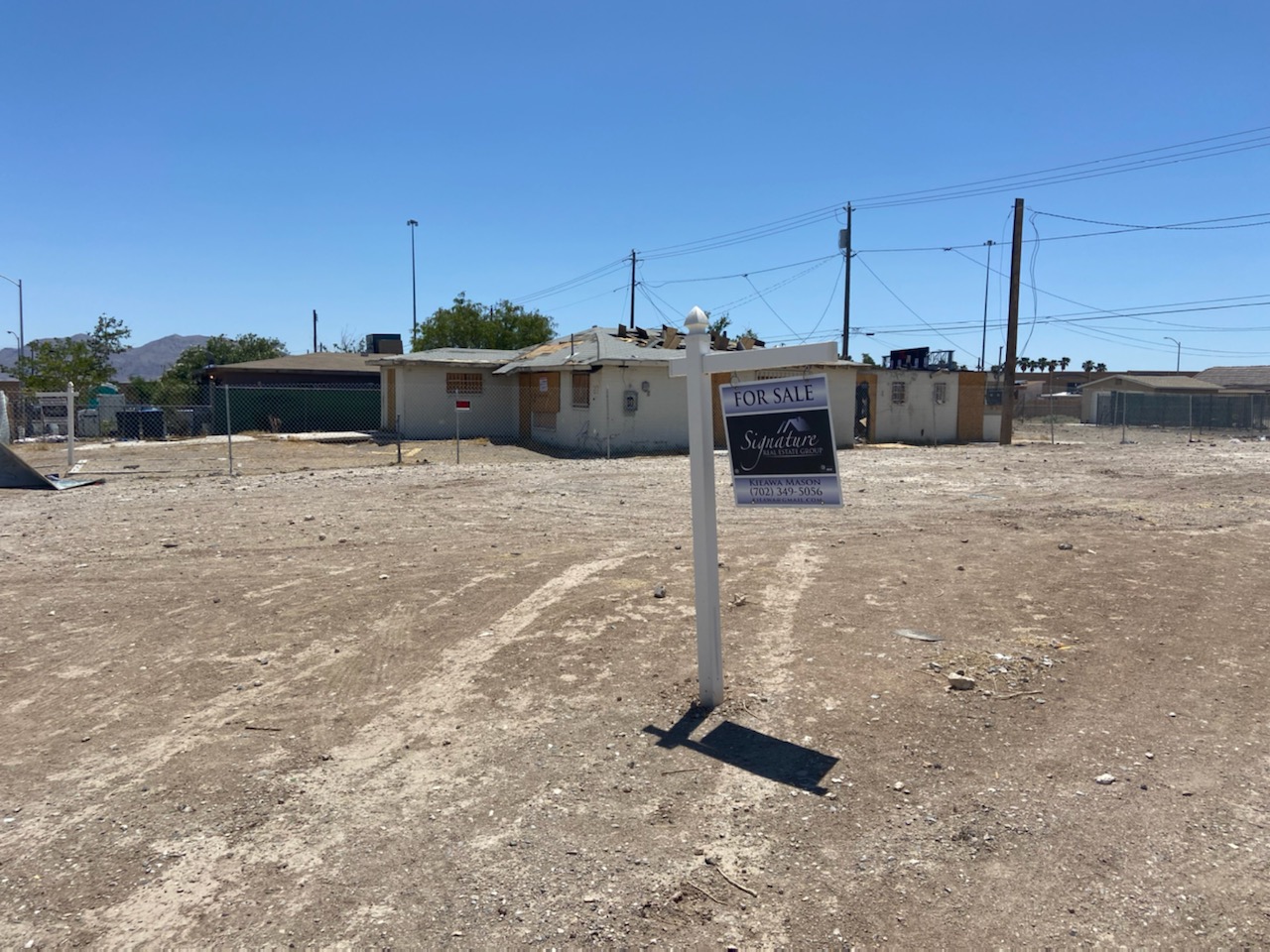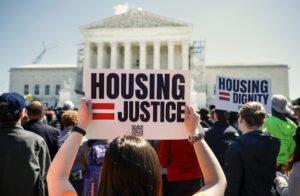6:00
News Story
Housing boom fails to spur revitalization of Historic Westside
City of Las Vegas sitting on vacant lots for decades
As buyers frantically plunk down tens of thousands of dollars over asking price to secure homes in the hottest real estate market in 15 years, Las Vegas’ Historic Westside remains blighted, littered with vacant lots, boarded up shacks and property values that lag the rest of the valley.
In May, the median price of a single family home sold in 89106 and 89030, the two zip codes that comprise the once predominantly African-American Historic Westside, was $269,000 — some $116,000 less than the valleywide median of $385,000.
“That’s high for over there,” says longtime real estate agent Wendell West.
Of the 4,100 homes sold valleywide in May, only 39 — less than 1% — were in the Historic Westside.
“Right now there are 34 available homes in 89106 and 89030. That’s the least it’s ever been in the 30 years I’ve been in business,” says West.
The scarcity of homes for sale is not for a lack of land. Vacant parcels are the norm on some streets.
“There are tons of single-family home lots on established streets with utilities ready to go,” says Las Vegan Ted Newkirk, whose family background is in real estate. “However, every couple of months, I look on Zillow and see that virtually none of them are for sale. And, when one comes up, it is priced a bit too high for the area.”
“We’ve had fire after fire after fire,” says Ward 5 Chamber of Commerce president Katie Duncan. “That has resulted in a lot of vacant land. And when people don’t pay their trash bill or their taxes, the property gets foreclosed. Probably the biggest owner of land is the City of Las Vegas.”
A review of Clark County Assessor’s records reveals the city owns at least 25 vacant lots on 17 different parcels on the blocks bordered by Interstate 15 to the east, Van Buren Avenue to the north, Martin Luther King Boulevard to the west, and Washington Avenue to the south.
The city has been sitting on some of the parcels since 1995, allowing blight to take root even as it reinvests in modest redevelopment efforts. Those investments pale in comparison to millions spent on public incentives and tax deferrals to spur development in Downtown Las Vegas, just on the other side of the interstate.
Home prices on the Westside have risen steadily in the last decade, but disregard from the city and cultural issues in the Black community have compounded the blight, says Duncan.
“Since desegregation, we’ve seen a continuous movement of younger people to the suburbs. As the older people have passed on, we haven’t learned to transfer wealth from one generation to the next,” she says. “We’ve seen a lot of death and then foreclosure, because whoever inherited the property didn’t have the skills to keep it up.”
West says he’s not surprised the city has demolished the buildings and left the lots vacant — until now.
“What are they going to do with them? Since 1995 the property values have gone up so they are now part of the plan,” he says.
The city did not respond to questions on Thursday and was closed Friday.
The 100 Plan, as it’s known, calls for the revitalization of Westside neighborhoods, including residential infill that is in keeping with the character of existing homes.
A city website indicates three community meetings were held last year on the 100 Plan. None have been held since September. City Councilman Cedric Crear, who represents Ward 5, did not respond to requests for comment.
Among the components of the plan is the redevelopment of Marble Manor, a public housing apartment complex at Washington Avenue and H Street.
“Adjacent investment in existing housing and infill of single family homes can reconnect residents and provide community spaces to enjoy,” says the document prepared by the city.
The 100 Plan also calls for “single family home improvements and infill” on Jackson Avenue, where the city owns at least five residential lots.
“To reintroduce a neighborhood feel to Jackson Ave., and to welcome new residents, the city of Las Vegas will work with homeowners and community partners to make investments in existing homes to improve and/or rehabilitate them, and will work to build new, affordable single-family homes on vacant lots,” the plan says.
The Nevada Preservation Foundation received $250,000 “in initial funding to establish a revolving loan fund to purchase, rehabilitate and sell residential properties in the Historic Westside,” according to the 100 Plan, which says 80 vacant homes are under consideration.
The nonprofit’s executive director, Cynthia Ammerman, was unable to say how many homes have been revitalized.
Another nonprofit, Neighborhood Housing Services of Southern Nevada Inc., “acquires, rehabilitates, and retains (or sells) vacant homes in the Historic Westside, and they are currently working with the city of Las Vegas to identify properties,” according to the 100 Plan.
Executive Director Michelle Merced says the organization is renovating a six-unit apartment building at 500 Jefferson for residents who have 80 percent or less of the area median income.
The Westside is “as diverse as any community in the valley,” says West of the area that is synonymous with the birth of Las Vegas.
In 1904, a surveyor named J.T. McWilliams sold lots at what would become known as McWilliams Townsite, and later, as the Westside, because it was located on the west side of the railroad tracks that played a pivotal role in the valley’s development. The economic despair of the area has since proved the Westside to be the “wrong side of the tracks.”
In the 1940s, 50s and early 60s, the Westside offered lodging and recreation to Black entertainers who were permitted to perform on the Las Vegas Strip but not sleep there. Today, Duncan owns the Harrison House, where Sammy Davis Jr. and other performers resided.
Today, about 40 percent of the area’s residents are Black, 38.2 percent are Hispanic, and 11 percent are white, according to the American Community Survey.
Home buyers are mostly entry-level and local, according to West.
“People from California don’t need a $200,000 to $300,000 house. They can buy in Summerlin or Green Valley,” he says.
Homebuyers also come from a variety of ethnic backgrounds.
“It’s been getting integrated. It used to be a majority of African-Americans, but now they are buying the least,” he says. “Asians and whites have been buying for the last 15 years.”
“Because the younger Blacks moved out, the Hispanics have moved in,” says Duncan. “I don’t see a huge Asian population. The convenience stores and businesses are owned by East Indians or Arabs.”
While single-family home prices in the Westside lag the rest of the valley, the median price of a condo or townhome in May was $206,000 compared with $205,000 valleywide — evidence of the product’s popularity in the neighborhood.
“That’s because the price of a condo normally starts with a ‘1’ in front of it. People are scared so they are just buying,” despite the increase in price, says West.
Scared, that is, of being locked out of a pricey market with nowhere to go.
“Before I could get a lock box, people were knocking on the door,” he says of a property he recently listed in the area.
Newkirk thinks builders, ravenous for land, are missing an opportunity in the Historic Westside.
“Younger people see color much less,” he says. “And honestly, much of Las Vegas is fairly diversified already.”
The lack of grocery stores in the community is less critical today, he says, because “people are relying on delivery more than ever,” for groceries and retail.
And finally, he adds, “Location, location, location. Yes, freeways divide communities. But, you are still five to seven minutes from East Fremont, Symphony Park, Arts District and with great freeway access in all directions.”
The acceleration of property values may slow soon, says West, especially on the Westside, where renters outnumber owners two to one, according to data from the American Community Survey. He expects the housing crunch to ease and more Westside properties to come on the market after July 1, when the federal eviction moratorium is scheduled to expire.
“I tell clients, if they were smart, they’d sell. Even first-time buyers are willing to pay a little over appraisal,” he says.
After July 1, “there are going to be a lot of evictions,” he says. “All hell is going to break loose.”
Our stories may be republished online or in print under Creative Commons license CC BY-NC-ND 4.0. We ask that you edit only for style or to shorten, provide proper attribution and link to our website. AP and Getty images may not be republished. Please see our republishing guidelines for use of any other photos and graphics.




